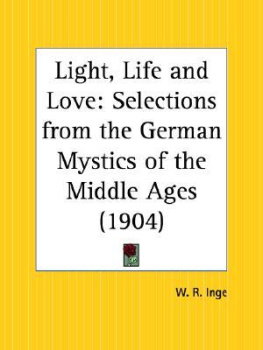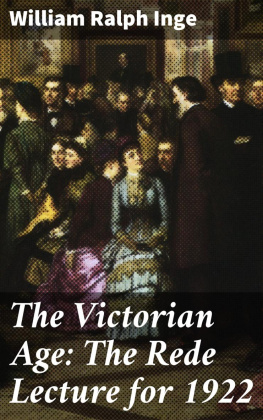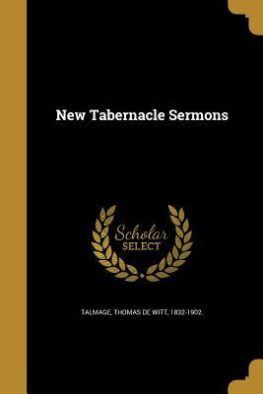The Project Gutenberg Etext of Light, Life, and Loveby W. R. Inge
Copyright laws are changing all over the world. Be sure to check thecopyright laws for your country before downloading or redistributingthis or any other Project Gutenberg file.
Please do not remove this header information.
This header should be the first thing seen when anyone starts toview the eBook. Do not change or edit it without written permission.The words are carefully chosen to provide users with the informationneeded to understand what they may and may not do with the eBook.To encourage this, we have moved most of the information to the end,rather than having it all here at the beginning.
**Welcome To The World of Free Plain Vanilla Electronic Texts**
**eBooks Readable By Both Humans and By Computers, Since 1971**
*****These eBooks Were Prepared By Thousands of Volunteers!*****
Information on contacting Project Gutenberg to get eBooks, andfurther information, is included below. We need your donations.
The Project Gutenberg Literary Archive Foundation is a 501(c)(3)organization with EIN [Employee Identification Number] 64-6221541Find out about how to make a donation at the bottom of this file.
Title: Light, Life, and Love
Author: W. R. Inge
Release Date: November, 2003 [Etext #4664]
[Yes, we are more than one year ahead of schedule]
[This file was first posted on February 25, 2002]
Edition: 10
Language: English
The Project Gutenberg Etext of Light, Life, and Love
by W. R. Inge
******This file should be named 4664.txt or 4664.zip******
Corrected EDITIONS of our etexts get a new NUMBER, lllov11.txt
VERSIONS based on separate sources get new LETTER, lllov10a.txt
Project Gutenberg eBooks are often created from several printededitions, all of which are confirmed as Public Domain in the USunless a copyright notice is included. Thus, we usually do notkeep eBooks in compliance with any particular paper edition.
The "legal small print" and other information about this bookmay now be found at the end of this file. Please read thisimportant information, as it gives you specific rights andtells you about restrictions in how the file may be used.
***This etext was produced by Charles Aldarondo.
LIGHT, LIFE, AND LOVE
Selections from the German Mystics of the Middle Ages
by
W. R. Inge
LONDON
Second Edition
1919
CONTENTS
INTRODUCTIONECKHARTTAULERMEDITATIONS ON THE SEVEN WORDS FROM THE CROSSSUSORUYSBROEKTHEOLOGIA GERMANICA
INTRODUCTION
Sect. 1. THE PRECURSORS OF THE GERMAN MYSTICS
TO most English readers the "Imitation of Christ" is therepresentative of mediaeval German mysticism. In reality, however,this beautiful little treatise belongs to a period when thatmovement had nearly spent itself. Thomas a Kempis, as Dr. Bigg hassaid,[1] was only a semi-mystic. He tones down the mostcharacteristic doctrines of Eckhart, who is the great originalthinker of the German mystical school, and seems in some ways torevert to an earlier type of devotional literature. The "Imitation"may perhaps be described as an idealised picture of monastic piety,drawn at a time when the life of the cloister no longer filled aplace of unchallenged usefulness in the social order of Europe. Tofind German mysticism at its strongest we must go back a fullhundred years, and to understand its growth we must retrace oursteps as far as the great awakening of the thirteenth centurytheage of chivalry in religionthe age of St. Louis, of Francis andDominic, of Bonaventura and Thomas Aquinas. It was a vast revival,bearing fruit in a new ardour of pity and charity, as well as in ahealthy freedom of thought. The Church, in recognising the newcharitable orders of Francis and Dominic, and the ChristianisedAristotelianism of the schoolmen, retained the loyalty and profitedby the zeal of the more sober reformers, but was unable to preventthe diffusion of an independent critical spirit, in part provokedand justified by real abuses. Discontent was aroused, not only bythe worldiness of the hierarchy, whose greed and luxurious livingwere felt to be scandalous, but by the widespread economic distresswhich prevailed over Western Europe at this period. The crusadesperiodically swept off a large proportion of the able-bodied men, ofwhom the majority never returned to their homes, and this helped toswell the number of indigent women, who, having no male protectors,were obliged to beg their bread. The better class of these femalemendicants soon formed themselves into uncloistered charitableOrders, who were not forbidden to marry, and who devoted themselveschiefly to the care of the sick. These Beguines and thecorresponding male associations of Beghards became very numerous inGermany. Their religious views were of a definite type. Theirs wasan intensely inward religion, based on the longing of the soul forimmediate access to God. The more educated among them tended toembrace a vague idealistic Pantheism. Mechthild of Magdeburg(1212-1277), prophetess, poetess, Church reformer, quietist, was theablest of the Beguines. Her writings prove to us that the technicalterminology of German mysticism was in use before Eckhart,[2] andalso that the followers of what the "Theologia Germanica" calls theFalse Light, who aspired to absorption in the Godhead, and despisedthe imitation of the incarnate Christ, were already throwingdiscredit on the movement. Mechthild's independence, and herunsparing denunciations of corruption in high places, brought herinto conflict with the secular clergy. They tried to burn herbooksthose religious love songs which had already endeared her toGerman popular sentiment. It was then that she seemed to hear avoice saying to her:
Lieb' meine, betrbe dich nicht zu sehr,
Die Wahrheit mag niemand verbrennen!
The rulers of the Church, unhappily, were not content with burningbooks. Their hostility towards the unrecognised Orders became moreand more pronounced: the Beghards and Beguines were harried andpersecuted till most of them were driven to join the Franciscans orDominicans, carrying with them into those Orders the ferment oftheir speculative mysticism. The more stubborn "Brethren and Sistersof the Free Spirit" were burned in batches at Cologne and elsewhere.Their fate in those times did not excite much pity, for many of thevictims were idle vagabonds of dissolute character, and the generalpublic probably thought that the licensed begging friars were enoughof a nuisance without the addition of these free lances.
The heretical mystical sects of the thirteenth century are veryinteresting as illustrating the chief dangers of mysticism. Some ofthese sectaries were Socialists or Communists of an extreme kind;others were Rationalists, who taught that Jesus Christ was the sonof Joseph and a sinner like other men; others were Puritans, whosaid that Church music was "nothing but a hellish noise" (nihil nisiclamor inferni), and that the Pope was the magna meretrix of theApocalypse. The majority were Anti-Sacramentalists and Determinists;and some were openly Antinomian, teaching that those who are led bythe Spirit can do no wrong. The followers of Amalric of Bena[3]believed that the Holy Ghost had chosen their sect in which tobecome incarnate; His presence among them was a continual guaranteeof sanctity and happiness. The "spiritual Franciscans" had dreams ofa more apocalyptic kind. They adopted the idea of an "eternalGospel," as expounded by Joachim of Floris, and believed that the"third kingdom," that of the Spirit, was about to begin amongthemselves. It was to abolish the secular Church and to inauguratethe reign of true Christianityi.e. "poverty" and asceticism.
Such are some of the results of what our eighteenth-centuryancestors knew and dreaded as "Enthusiasm"that ferment of thespirit which in certain epochs spreads from soul to soul like anepidemic, breaking all the fetters of authority, despising traditionand rejecting discipline in its eagerness to get rid of formalismand unreality; a lawless, turbulent, unmanageable spirit, in which,notwithstanding, is a potentiality for good far higher than any towhich the lukewarm "religion of all sensible men" can ever attain.For mysticism is the raw material of all religion; and it is easierto discipline the enthusiast than to breathe enthusiasm into thedisciplinarian.
Next page



